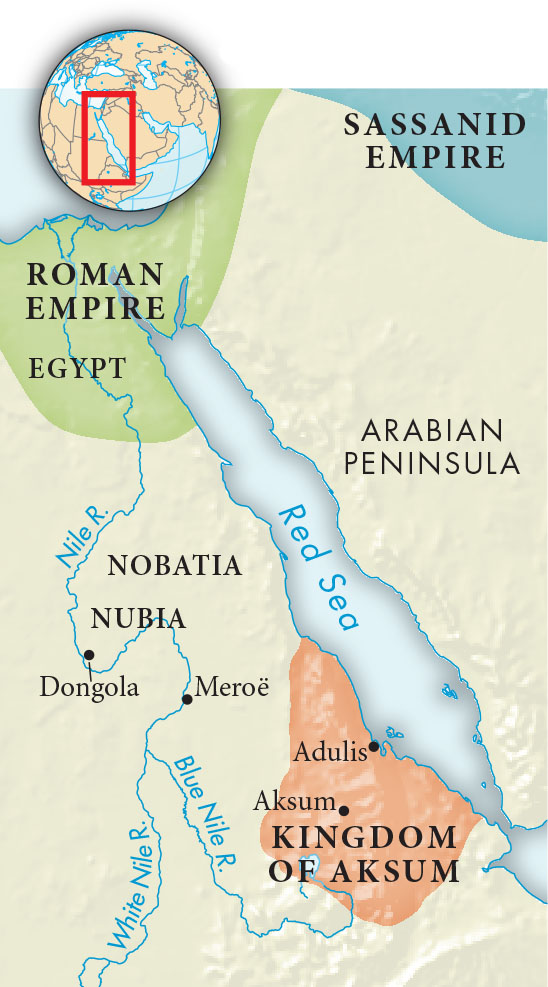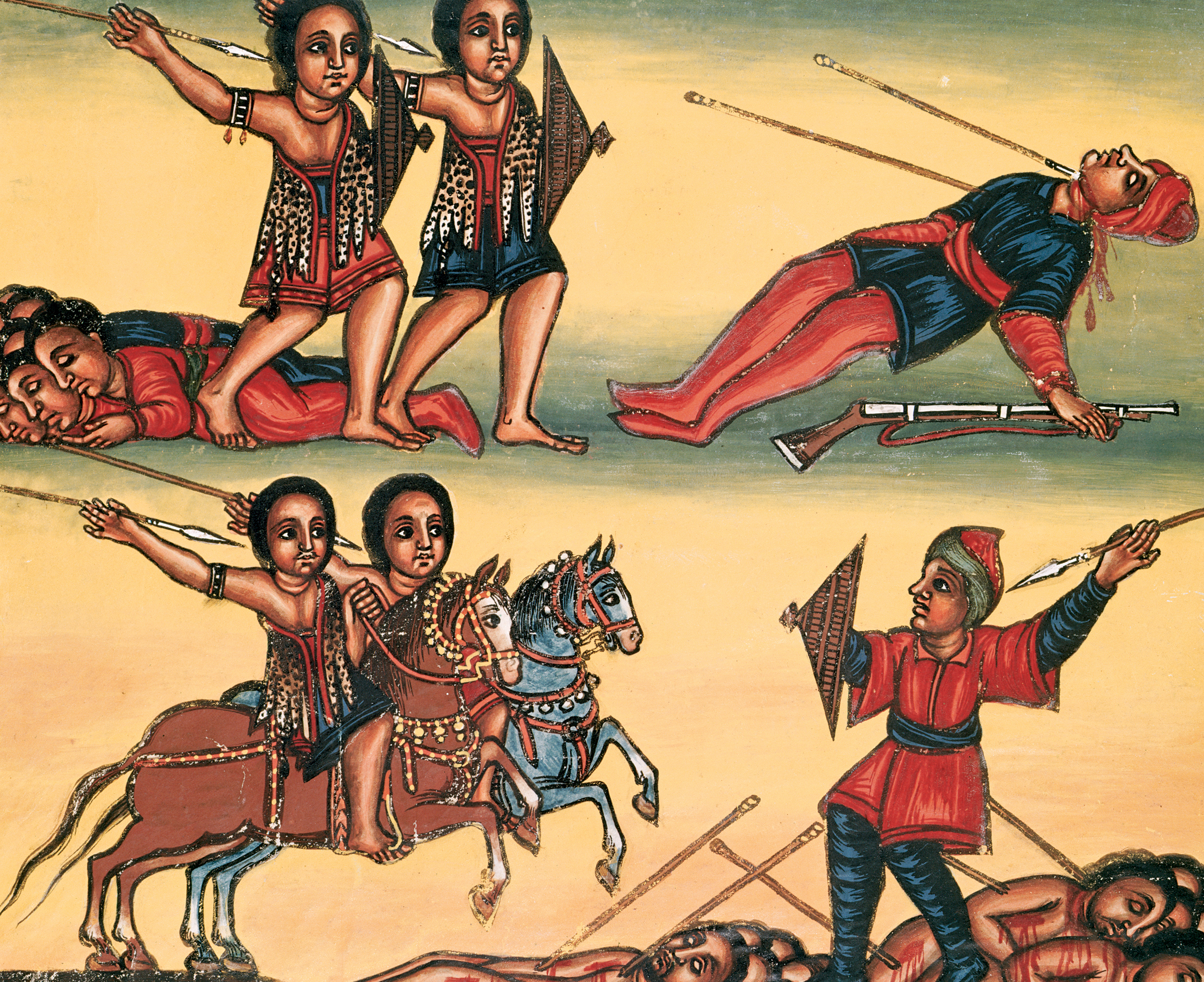A History of World Societies:
Printed Page 281
A History of World Societies Value
Edition: Printed Page 283
Chapter Chronology
Ethiopia: The Christian Kingdom of Aksum

The Kingdom of Aksum, ca. 600
Just as the ancient West African empires were significantly affected by Islam and the Arab culture that accompanied it, the African kingdoms that arose in modern Sudan and Ethiopia in northeast Africa were heavily influenced by Egyptian culture, and they influenced it in return. This was particularly the case in ancient Nubia. Nubia’s capital was at Meroë (see Map 10.2); thus the country is often referred to as the Nubian kingdom of Meroë.
As part of the Roman Empire, Egypt was subject to Hellenistic and Roman cultural forces, and it became an early center of Christianity. Nubia, however, was never part of the Roman Empire; its people clung to ancient Egyptian religious ideas. Christian missionaries traveled to the Upper Nile region and successfully converted the Nubian rulers around 600 C.E. By that time, there were three separate Nubian states, of which the kingdom of Nobatia, centered at Dongola, was the strongest. The Christian rulers of Nobatia had close ties with the Aksum kingdom in Ethiopia, and through this relationship Egyptian culture spread to Ethiopia.
Two-thirds of Ethiopia consists of the Ethiopian highlands, the rugged plateau region of East Africa. The Great Rift Valley divides this territory into two massifs (mountain masses), of which the Ethiopian Plateau is the larger. Sloping away from each side of the Great Rift Valley are a series of mountains and valleys. Together with this mountainous environment, the three Middle Eastern religions — Judaism, Christianity, and Islam — have all influenced Ethiopian society.
By the first century C.E. the Aksum kingdom in northwestern Ethiopia was a sizable trading state. Merchants at Adulis, its main port on the Red Sea, sold ivory, gold, emeralds, rhinoceros horns, shells, and slaves to the Sudan, Arabia, Yemen, and various cities across the Indian Ocean in exchange for glass, ceramics, fabrics, sugar, oil, spices, and precious gems. Adulis contained temples, stone-built houses, and irrigated agriculture. Between the first and eighth centuries Aksum served as the capital of an empire extending over much of what is now northern Ethiopia. The empire’s prosperity rested on trade. Aksum even independently minted specie (coins) modeled on the Roman solidus; at that time, only the Roman Empire, Persia, and some Indian states issued coins that circulated in Middle Eastern trade. It was the first and only sub-Saharan African state to have its own currency. After Aksum’s decline, coins were not minted again in Africa until the Swahili city-state of Kilwa minted gold coins beginning perhaps as early as the eleventh century.

Christianity and Islam in Ethiopia The prolonged contest between the two religions in Ethiopia was periodically taken to the battlefield. This drawing from the eighteenth century by an Ethiopian artist shows his countrymen (left) advancing victoriously and celebrates national military success. (© The British Library Board/The Image Works)
Islam’s expansion into northern Ethiopia in the eighth century (see “The Spread of Islam in Africa”) weakened Aksum’s commercial prosperity. The Arabs first ousted the Greek Byzantine merchants who traded on the Dahlak Archipelago (in the southern Red Sea) and converted the islands’ inhabitants. Then Muslims attacked and destroyed Adulis. Some Aksumites converted to Islam; many others found refuge in the rugged mountains north of the kingdom, where they were isolated from outside contacts. Thus began the insularity that characterized later Ethiopian society.
Tradition ascribes to Frumentius (ca. 300–380 C.E.), a Syrian Christian trader, the introduction of Coptic Christianity, an Orthodox form of Christianity that originated in Egypt, into Ethiopia. Kidnapped as a young boy en route from India to Tyre (in southern Lebanon), Frumentius was taken to Aksum, given his freedom, and appointed tutor to the future king, Ezana. Upon Ezana’s accession to the throne, Frumentius went to Alexandria, Egypt, where he was consecrated the first bishop of Aksum around 328 C.E. He then returned to Ethiopia with some priests to spread Christianity. Shortly after members of the royal court accepted Christianity, it became the Ethiopian state religion. Ethiopia’s future was to be inextricably linked to Christianity, a unique situation in sub-Saharan Africa.
Ethiopia’s acceptance of Christianity led to the production of ecclesiastical documents and royal chronicles, making Ethiopia the first sub-Saharan African society that can be studied from written records. The Scriptures were translated into Ge’ez (gee-EHZ), an ancient language and script used in Ethiopia and Aksum. Pagan temples were dedicated to Christian saints, and, as in early medieval Ireland and in the Orthodox Church of the Byzantine world, monasteries were the Christian faith’s main cultural institutions in Ethiopia. Monks preached and converted the people, who resorted to the monasteries in times of need. As the Ethiopian state expanded, vibrant monasteries provided inspiration for the establishment of convents for nuns, as in medieval Europe (see “Monastic Life” in Chapter 14).
Monastic records provide fascinating information about early Ethiopian society. Settlements were formed on the warm and moist plateau lands, not in the arid lowlands or the river valleys. Farmers used a scratch plow (unique in sub-Saharan Africa) to cultivate wheat and barley, and they regularly rotated these cereals. Plentiful rainfall seems to have helped produce abundant crops, which in turn led to population growth. Unlike in most of sub-Saharan Africa, both sexes probably married young. Because of ecclesiastical opposition to polygyny (the practice of having multiple wives), monogamy was the norm, other than for kings and the very rich. An abundance of land meant that young couples could establish independent households. Widely scattered farms, with the parish church as the central social unit, seem to have been the usual pattern of existence.
Above the broad class of peasant farmers stood warrior-nobles. Their wealth and status derived from their fighting skills, which kings rewarded with grants of estates and with the right to collect tribute from the peasants. To acquire lands and to hold warriors’ loyalty, Ethiopian kings pursued a policy of constant territorial expansion. (See “Individuals in Society: Amda Siyon.”) Nobles maintained order in their regions, supplied kings with fighting men, and displayed their superior status by the size of their households and their generosity to the poor.
Sometime in the fourteenth century, six scribes in the Tigrayan highlands of Ethiopia combined oral tradition, Jewish and Islamic commentaries, apocryphal (noncanonical) Christian texts, and the writings of the early Christian Church fathers to produce the Kebra Nagast (The Glory of Kings). This history served the authors’ goals: it became an Ethiopian national epic, glorifying a line of rulers descended from the Hebrew king Solomon (see “The Hebrew State” in Chapter 2), arousing patriotic feelings, and linking Ethiopia’s identity to the Judeo-Christian tradition. The book mostly deals with the origins of Emperor Menilek I of Ethiopia in the tenth century B.C.E.
The Kebra Nagast asserts that Queen Makeda of Ethiopia (called Sheba in the Jewish tradition) had little governmental experience when she came to the throne. So she sought the advice and wise counsel of King Solomon (r. 965–925 B.C.E.) in Jerusalem. Makeda learned Jewish statecraft, converted to Judaism, and expressed her gratitude to Solomon with rich gifts of spices, gems, and gold. Desiring something more precious, Solomon prepared a lavish banquet for his attractive pupil. Satiated with spicy food and rich wines, Makeda fell asleep. In the middle of the night Solomon tricked Makeda into allowing him into her bed. Their son, Menilek, was born some months later. When Menilek reached maturity, he visited Solomon in Jerusalem. There Solomon anointed him crown prince of Ethiopia and sent a retinue of young Jewish nobles to accompany him home as courtiers. Unable to face life without the Hebrews’ Ark of the Covenant, the courtiers stole the cherished wooden chest, which the Hebrews believed contained the Ten Commandments. God apparently approved the theft, for he lifted the youths, pursued by Solomon’s army, across the Red Sea and into Ethiopia. Thus, according to the Kebra Nagast, Menilek avenged his mother’s shame, and God gave his legal covenant to Ethiopia, Israel’s successor.13 Although written around twenty-three hundred years after the events, the myths and legends contained in the Kebra Nagast effectively served the purpose of building nationalistic fervor.

Picturing the PastThe Queen of Sheba and King Solomon Sheba, Queen Makeda, figured prominently in European as well as Ethiopian art. Created in about 1180 by a French artist as part of a series of biblical scenes for an abbey in Austria, this image shows Solomon receiving gifts from Sheba’s servants. The inscription surrounding the scene reads “Solomon joins himself to the Queen of Sheba and introduces her to his faith.” (Erich Lessing/Art Resource, NY)ANALYZING THE IMAGE What are King Solomon and Queen Sheba wearing and holding? How are the other figures depicted, and what are they doing?CONNECTIONS What does the style of this image suggest about the background of the artist and about the audience for whom the image was intended?
Based on this lineage, from the tenth to the sixteenth centuries, and even in the Ethiopian constitution of 1955, Ethiopia’s rulers claimed they belonged to the Solomonic line of succession. Thus the church and state in Ethiopia were inextricably linked.
Ethiopia’s high mountains isolated the kingdom and hindered access from the outside, but through trade word gradually spread about this African kingdom’s Christian devotion. Twelfth-century Crusaders returning from the Middle East told of a powerful Christian ruler, Prester John, whose lands lay behind Muslim lines and who was eager to help restore the Holy Land to Christian control. The story of Prester John sparked European imaginations and led to exploration aimed at finding his legendary kingdom, which was eventually identified with Ethiopia. In the later thirteenth century the dynasty of the Solomonic kings witnessed a literary and artistic renaissance particularly notable for works of hagiography (biographies of saints), biblical exegesis (critical explanation or interpretation of the Bible), and manuscript illumination. The most striking feature of Ethiopian society from 500 to 1500 was the close relationship between the church and the state. Christianity inspired fierce devotion and equated doctrinal heresy with political rebellion, thus reinforcing central monarchical power.


